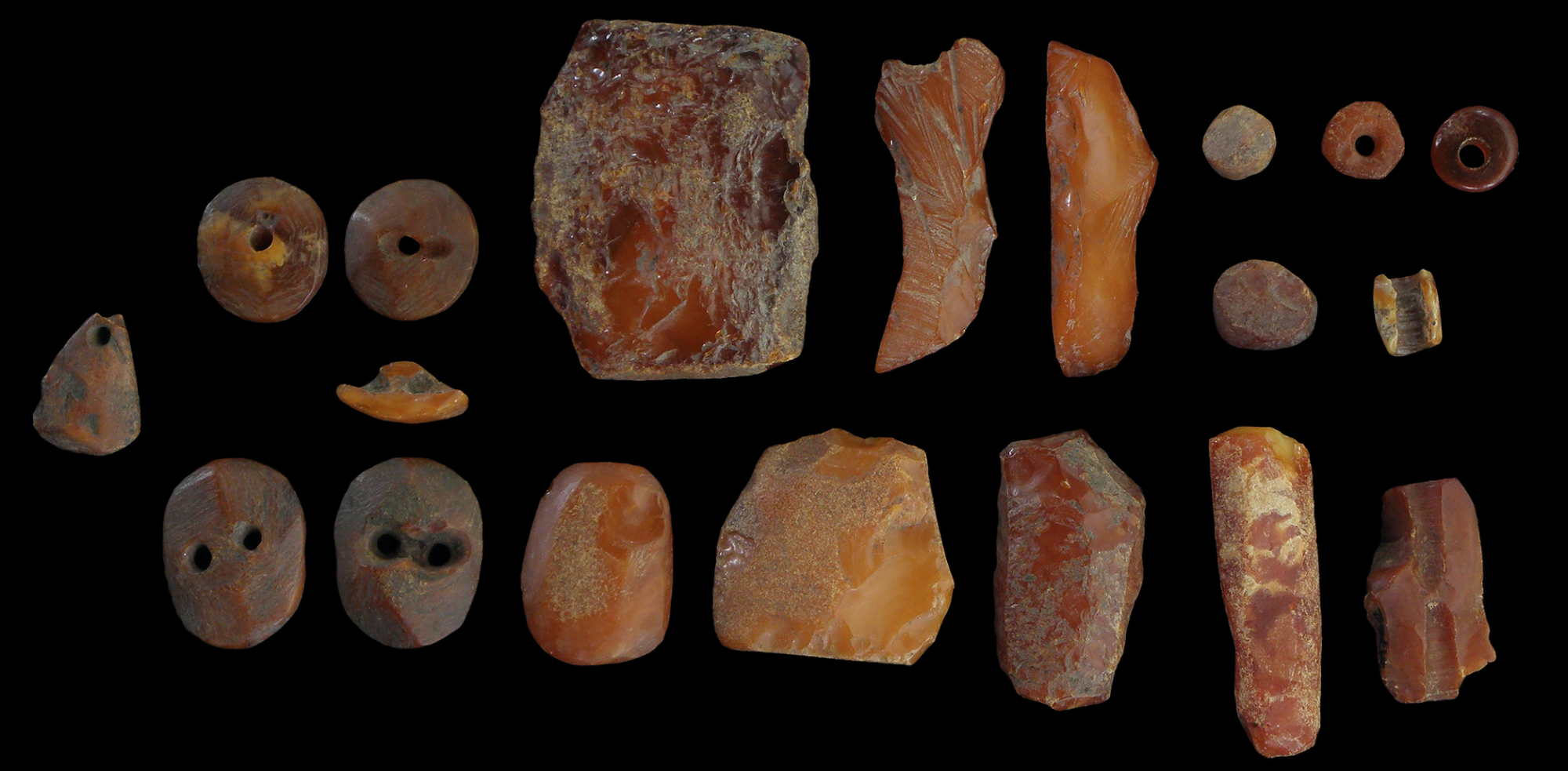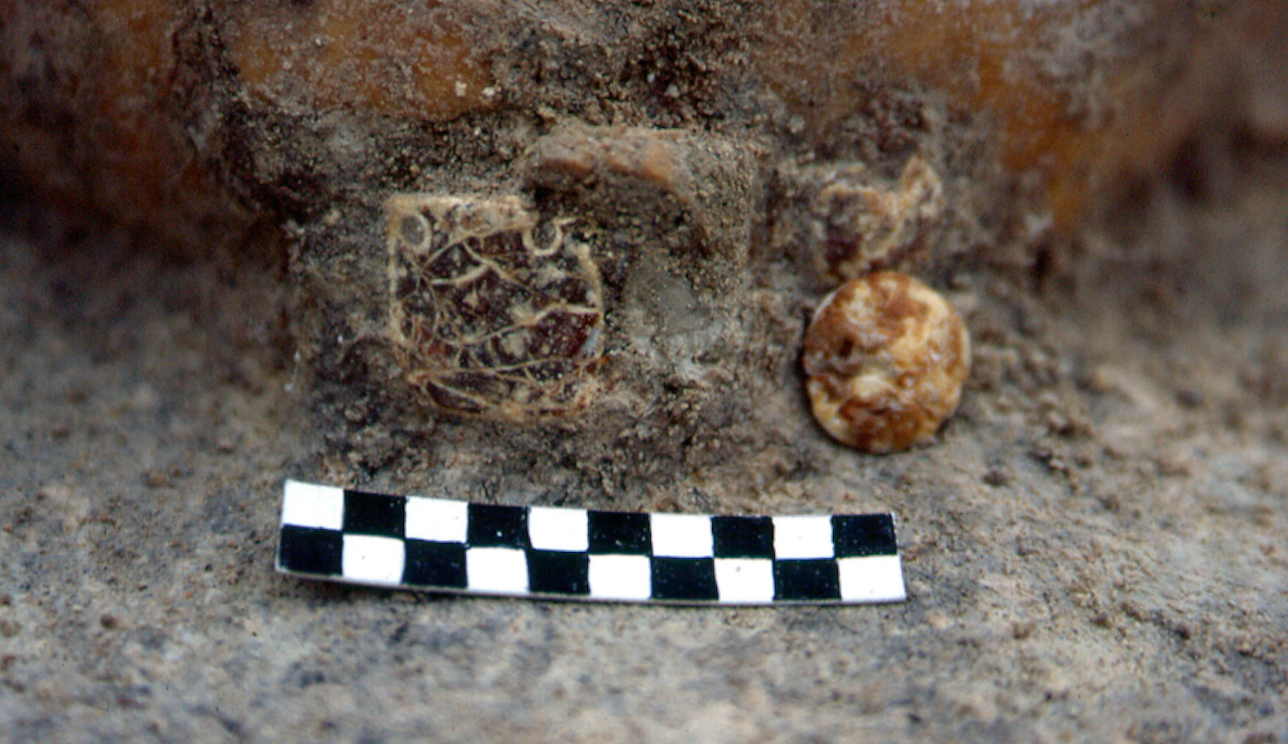The area of the south-eastern shores of the Baltic Sea was in prehistory and is still today an area abundant in deposits of raw amber, as indicated, among other things, by the numerous Late Neolithic (3rd millennium BC) amber workshops and amber ornaments found on archaeological sites located in the Vistula Fens, south of the Gulf of Gdańsk. Therefore, it is puzzling that relatively few finished amber ornaments come from both these areas and the nearby region of north-eastern Poland. Among the few contemporary known ornaments are those from sites: Ząbie 10, Supraśl 3 and Supraśl 6, which are unique in this part of the prehistoric world. The selected artifacts were thus subjected to stylistic and technological analysis in order to determine where they were made, also taking into account the type of raw material used. The research showed that although the amber ornaments were most likely produced from material extracted in the south-eastern Baltic coastal zone (succinite, gedanite and gedano-succinite), they have no direct analogues there.

© K. Kwiatkowska, on licence CC BY-ND 4.0
Amber – the gold of the north and tears of the gods
Amber is one of the many fossil resins used by humanssince the Upper Palaeolithic period. However, it should be remembered that what is conventionally called ‘amber’ is actually more than 100 different types of fossilized resins found on all continents. The main criterion for its division into different types are its physical and chemical characteristics, and above all the content of the so-called succinic acid, the highest level of which is recorded in succinite, usually referred to as Baltic amber. Another important factor distinguishing fossilized resins is the time of resinification of the trees, as well as the conditions and period of the hardening of the substance. Palaeolinguistic research indicates that in various communities most of its names refer to visual impressions. It is believed that it was seen as a source of divine/supernatural power, linking it to the element of fire and solar mythology. One of the best prehistoric examples of this kind of understanding of amber in Europe are the Late Neolithic amber discs. Sometimes decorated with solar motifs, they were usually found in funerary or votive contexts. Amber was also used to make many prestigious objects – jewelry and clothing accessories, sometimes combining it with gold, and later also with copper and bronze. In many communities, therefore, it was a valuable and desirable raw material, which was probably also associated with the high status of the owners of amber products, and the raw material itself was referred to as the ‘gold of the north’. Its elite nature and the desire to possess it attracted many, so it was distributed from the zone of its natural occurrence to distant parts of the “Old World ” either as a raw material or in the form of finished products.
In Poland, the areas that are the most abundant in discoveries of amber objects, although mainly related to processing workshops, are the sites of the Late Neolithic Rzucewo culture, which occupied the areas of the south-eastern shores of the Baltic Sea. Other, already less numerous finds, are finished products placed in the graves of the Złota culture from southern Poland or the Globular Amphora culture. In the latter case, amber ornaments were most often found in megalithic contexts and were discovered throughout the geographical span of this prehistoric society.
It may therefore be surprising that relatively few sites with amber artifacts have been discovered in the area of north-eastern Poland, including the immediate vicinity of the amber workshops of the Rzucewo culture. Again, these are mainly graves of the Globular Amphora culture, explored as late as the end of the 19th or early 20th century AD. Unfortunately, the artifacts from these contexts have not survived to the present day, having perished during the Second World War, making a comprehensive analysis impossible.
However, contemporary research has provided further Late Neolithic amber artifacts. These have been subjected to modern research procedures, including determining the impact of post-depositional changes to ascertain the influence of the immediate environment on the destruction of these artifacts.
Neolithic amber workshops in Poland
The importance of amber in Late Neolithic communities is evidenced not only by finds of finished products from graves, but primarily by the discovery of extensive and long-lasting amber workshops in the vicinity of the Niedźwiedziówka village in Żuławy Wiślane. Archaeological research carried out in the area since the late 1970s and early 1980s has contributed to the discovery and documentation of numerous amber workshops dating back to the 3rd millennium BC. They yielded numerous ecofacts and artifacts, among which amber materials were prominent. These were mainly production waste, forms abandoned and damaged at various stages of production, or nuggets of discarded raw material. What was noticeable in the analyses of amber sources, was the almost total absence of finished products. Due to the marshland conditions of their discovery, which also facilitated their preservation, traces of the use of flint, stone and bone ‘jewelry’ tools were also evident.

© K. Kwiatkowska, on licence CC BY-ND 4.0
Late Neolithic amber ornaments from north-eastern Poland
A group of 59 amber ornaments, beads and pendants, from three sites in north-eastern Poland were analyzed: Ząbie 10 (Warmian-Masurian Voivodeship), Supraśl 3 and 6 (Podlaskie Voivodeship). Of these, 50 ornaments formed the inventory of a single man’s grave, while nine were discovered in other ritual features at two sites near Supraśl.
Stylistic and technological analyses showed that the specimens from Ząbie in the Masurian Lake District have no direct analogues among the different materials known from the European area. They have some parallels only in regards to the technological aspect of their making, as a drill with a metal (most likely copper) tool was used to make the drilled holes, which was also documented in the case of finds from the Supraśl sites. The use of this type of tool for amber processing at that time has been recorded only in southern (‘Mediterranean’) Europe and the British Isles. The style in which the ornaments from the Supraśl ritual features were made, having in turn analogies in the materials of the Bell Beaker culture, could also have contact with these areas.
The application of chemical analyses using Fourier Transform Infrared Spectroscopy (FTIR) to selected artifacts from the sites mentioned above, allowed to determine the type of raw material and its degree of weathering. These studies showed that the artifacts were made mainly from succinite, and in three cases from gedano-succinite and gedanite, thus the so-called Baltic amber. In contrast, the degree of impact of post-depositional alteration varied considerably and depended on the surrounding environment.

© D.Manasterski, on licence CC BY-ND 4.0
Conclusions
Despite the close proximity of areas rich in raw amber and places of its processing, the area of north-eastern Poland is relatively poor in finds of finished products dated to the Late Neolithic. However, it cannot be excluded that this is only an apparent situation, due to post-depositional processes which can lead to complete weathering of the raw material, which then becomes ‘invisible’ in the surrounding sand grains. Analyses of the currently available Late Neolithic amber artifacts from the area have provided interesting information related to their processing.
After comparing them with material from amber workshops in the vicinity of the Niedźwiedziówka village in the Vistula Fens, dated to the same period, it can be concluded that they were not made there, which rules out their Visual Fens provenance. FTIR spectroscopy, on the other hand, showed that they were made from local raw material, i.e. Baltic amber, and not from other fossil resins (e.g. sicilian amber or rumanite), which were also used to make ornaments at that time. The results allow two equally valid hypotheses to be put forward regarding the origin of the ornaments. The first suggests that they were made locally by some itinerant ‘jewelers’ processing amber with copper tools from the local raw material. The second is that these objects arrived with their owners from other, but as yet undetermined, areas. In the case of the 50 beads found in the burial of the man from Ząbie, we should consider areas rich in large nuggets of high quality amber as a source, since the beads deposited in the grave were of considerable size and were characterized, apart from the consistent style of composition of all ornaments (necklace, belt and bracelets), by the uniform character of the raw material chosen for their manufacture. These indications point towards the production of the whole set of ornaments in a specialized workshop with access to high-quality amber. Unfortunately, no such Late Neolithic workshop has yet been discovered anywhere in Europe.
Reference:
Dariusz Manasterski, Ewa Wagner-Wysiecka, Katarzyna Kwiatkowska, Aleksandra Cetwińska, Provenance studies on Late Neolithic amber ornaments from North-East Poland, Journal of Archaeological Science: Reports, Volume 44, 2022, 103540, ISSN 2352-409X, https://doi.org/10.1016/j.jasrep.2022.103540.
Free download until 19 August at this link:
https://authors.elsevier.com/c/1fKZg,rVDBbx9q
This article may be freely reprinted with photographs, with reference to the source
Authors:
Dariusz Manasterski – Assistant professor at the Faculty of Archaeology, University of Warsaw;
Ewa Wagner-Wysiecka – Head of the Department of Chemistry and Technology of Functional Materials, Faculty of Chemistry, Gdańsk University of Technology;
Katarzyna Kwiatkowska – Head of the Amber Department of the Polish Academy of Sciences Museum of the Earth in Warsaw;
Aleksandra Cetwińska – PhD candidate at the Antiquity of Southeastern Europe Research Centre, University of Warsaw.
Editing: AB
Proofreadnig: Dániel Takács
